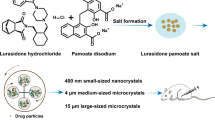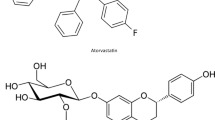Abstract
Many formulation and manufacturing processes can lead to morphological and crystalline transitions in many polycrystalline drugs, changing the properties of active pharmaceutical ingredients (APIs) such as solubility and physical stability which influence their therapeutic effects and safety and so limit their usefulness. Here, we report significant changes in crystal forms and morphology, including the shape and size of particles during the manufacture of off-white aripiprazole (APZ) dry powders used for long-acting and injectable suspensions. With the optimal top-down approach, powders were prepared by recrystallizing uniform monohydrous APZ (MA) and polycrystalline anhydrous APZ (AA) form III, characterized by thermal analysis, PXRD, and FT-IR. However, powders involving MA (MAP) with a lower mean size (2.126 μm), narrower distribution (span = 1.90), and higher stability compared with AA dry powders (AAP) were found to exhibit dehydration behavior and morphological changes after completion of the preparation processes based on the results of thermal analysis. In the case of APZ powders, we wished to obtain more information to guide in the industrial production and experimental design of suspensions in the future.








Similar content being viewed by others
References
Potkin SG, Preda A. Aripiprazole once-monthly long-acting injectable for the treatment of schizophrenia. Expert Opin Pharmacother. 2016;17(3):395–407.
Chue P, Chue J. A review of aripiprazole long-acting injection. Current medical research and opinion. 2015;1–12.
Zhu Z. Flash nanoprecipitation: prediction and enhancement of particle stability via drug structure. Mol Pharm. 2014;11(3):776–86.
Cresswell P, Paquette SM, Hickey M, Perkin K, Smith G, Liversidge E, et al. ARIPIPRAZOLE PRODRUG COMPOSITIONS. US Patent. 2016; 20,160,045,495.
Citrome L. Aripiprazole long-acting injectable formulations for schizophrenia: aripiprazole monohydrate and aripiprazole lauroxil. Expert review of clinical pharmacology. 2015;1–18.
Kostanski JW, Matsuda T, Nerurkar M, Naringrekar VH. Controlled release sterile injectable aripiprazole formulation and method. Google Patents. 2015.
Banfield JF, Welch SA, Zhang H, Ebert TT, Penn RL. Aggregation-based crystal growth and microstructure development in natural iron oxyhydroxide biomineralization products. Science. 2000;289(5480):751–4.
Łaszcz M, Witkowska A. Studies of phase transitions in the aripiprazole solid dosage form. J Pharm Biomed Anal. 2016;117:298–303.
Delaney SP, Pan D, Yin SX, Smith TM, Korter TM. Evaluating the roles of conformational strain and cohesive binding in crystalline polymorphs of aripiprazole. Cryst Growth Des. 2013;13(7):2943–52.
Braun DE, Gelbrich T, Kahlenberg V, Tessadri R, Wieser J, Griesser UJ. Stability of solvates and packing systematics of nine crystal forms of the antipsychotic drug aripiprazole. Cryst Growth Des. 2008;9(2):1054–65.
Kesisoglou F, Panmai S, Wu Y. Nanosizing—oral formulation development and biopharmaceutical evaluation. Adv Drug Deliv Rev. 2007;59(7):631–44.
Chaubal MV, Popescu C. Conversion of nanosuspensions into dry powders by spray drying: a case study. Pharm Res. 2008;25(10):2302–8.
Hartman P. Crystal growth: an introduction: North Holland. 1973.
Zhan H, Yang X, Wang C, Chen J, Wen Y, Liang C, et al. Multiple nucleation and crystal growth of barium titanate. Cryst Growth Des. 2012;12(3):1247–53.
Griesser U, Hilfiker R. Polymorphism in the Pharmaceutical Industry. ed Rolf Hilfiker, Wiley-VCH Verlag GmbH & Co. 2006; 211–33.
Avdeef A, Tsinman O. Miniaturized rotating disk intrinsic dissolution rate measurement: effects of buffer capacity in comparisons to traditional Wood’s apparatus. Pharm Res. 2008;25(11):2613–27.
Florey K. Profiles of drug substances, excipients and related methodology. New York: Academic; 1983.
Brittain HG. Aripiprazole: polymorphs and solvatomorphs. Prof Drug Subs Ex Relat Method. 2012;37:1–29.
Kimura T, Koga N. Thermal dehydration of monohydrocalcite: overall kinetics and physico-geometrical mechanisms. J Phys Chem A. 2011;115(38):10491–501.
Liu R, Liu F, Zhao S, Su Y, Wang D, Shen Q. Crystallization and oriented attachment of monohydrocalcite and its crystalline phase transformation. Cryst Eng Comm. 2013;15(3):509–15.
Liu T, Ran Y, Wang B, Dong W, Wu S, Gong J. The dehydration behavior and non-isothermal dehydration kinetics of donepezil hydrochloride monohydrate (form I). Front Chem Sci Eng. 2014;8(1):55–63.
Zhou W. Reversed crystal growth: implications for crystal engineering. Adv Mater. 2010;22(28):3086–92.
Xu Y, Liu X, Lian R, Zheng S, Yin Z, Lu Y, et al. Enhanced dissolution and oral bioavailability of aripiprazole nanosuspensions prepared by nanoprecipitation/homogenization based on acid–base neutralization. Int J Pharm. 2012;438(1):287–95.
Sander JR, Bučar D-K, Baltrusaitis J, MacGillivray LR. Organic nanocrystals of the resorcinarene hexamer via sonochemistry: evidence of reversed crystal growth involving hollow morphologies. J Am Chem Soc. 2012;134(16):6900–3.
Acknowledgments
This research was supported by a grant from the National Science Foundation for Fostering Talents in Basic Research of China (Grant No. J1103606).
Author information
Authors and Affiliations
Corresponding author
Additional information
Xinyi Tan and Yue Zhong contributed equally to this work.
Rights and permissions
About this article
Cite this article
Tan, X., Zhong, Y., He, L. et al. Morphological and Crystalline Transitions in Monohydrous and Anhydrous Aripiprazole for a Long-Acting Injectable Suspension. AAPS PharmSciTech 18, 1270–1276 (2017). https://doi.org/10.1208/s12249-016-0592-1
Received:
Accepted:
Published:
Issue Date:
DOI: https://doi.org/10.1208/s12249-016-0592-1




